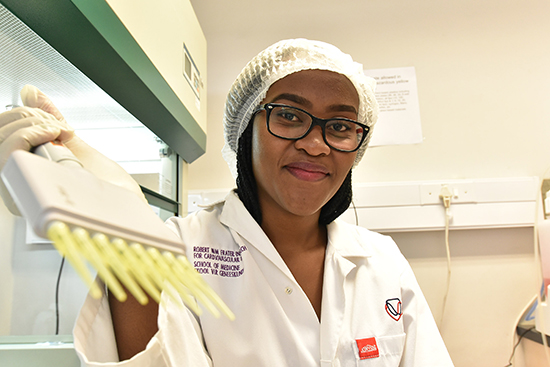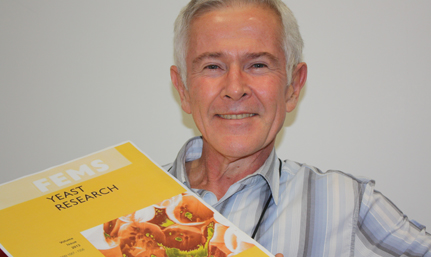Latest News Archive
Please select Category, Year, and then Month to display items
17 September 2018
Photo Charl Devenish
 Innocensia Mangoato’s research on using cannabis to reverse anticancer drug resistance has been awarded in the prestigious Women in Science Awards.
Innocensia Mangoato’s research on using cannabis to reverse anticancer drug resistance has been awarded in the prestigious Women in Science Awards.
“There’s this misconception among young people that science is difficult and that it’s somehow a man’s domain,” says Innocensia Mangoato, Masters student in Pharmacology, who has just been awarded in the prestigious Women in Science Awards by the Department of Science and Technology.
Cannabis research
Innocensia won in the Master’s Degree category for her research on the use of cannabis in reversing anticancer drug resistance. Her department had to apply for a special permit to grow cannabis for research and medicinal purposes.
“Her findings have already indicated a promising reversal of resistance to drugs in a variety of cancers. We plan to explore these results further in a possible PhD,” says her study leader, Prof Motlalepula Matsabisa.
Innocensia says she’s always had an interest in science, and initially wanted to study medicine. She ended up doing a BSc in Physiology and Genetics.
She hopes that her research will help government to develop a policy around the use of cannabis for medicinal purposes which could ultimately lead to developing cancer treatment with fewer side-effects.
Female mentors
“My mentor during my Honours studies was Dr Makhotso Lekhoa. Her passion for her field and her patience in conveying it to others really inspired me. We have some very powerful women in our Pharmacology Department,” says Innocensia.
Passion for science
“You know you’re passionate about your work when you find yourself going to the lab on Sunday afternoons!” she says. “I’m happy that I can be contributing to the knowledge production on this campus. And maybe one day I can be a mentor to other girls with that same passion for science.”
Link between champagne bubbles and the UFS?
2012-11-16
 |
|
Prof. Lodewyk Kock with an example of a front page of the publication FEMS Yeast Research, as adapted by F. Belliard, FEMS Central Office.
Photo: Leatitia Pienaar
15 November 2012
|
What is the link between the bubbles in champagne and breakthrough research being done at the Mayo Clinic in America? Nano research being done at our university.
Prof. Lodewyk Kock of Biotechnology says a human being consists of millions of minute cells that are invisible to the eye. The nano technology team at the UFS have developed a technique that allows researchers to look into such a cell, as well as other microorganisms. In this way, they can get an idea of what the cell’s “insides” look like.
The UFS team – consisting of Profs. Kock, Hendrik Swart (Physics), Pieter van Wyk (Centre for Microscopy), as well as Dr Chantel Swart (Biotechnology), Dr Carlien Pohl (Biotechnology) and Liza Coetsee (Physics) – were amazed to see that the inside of cells consist of a maze of small tunnels or blisters. Each tunnel is about 100 and more nanometres in diameter – about one ten thousandth of a millimetre – that weaves through the cells in a maze.
It was also found that these tunnels are the “lungs” of the cells. Academics doing research on yeast have had to sit up and take notice of the research being done at the UFS – to the extent that these “lungs” will appear on the front page of the highly acclaimed FEMS Yeast Research for all of 2013.
The Mayo Clinic, in particular, now wants to work with the UFS to study cancer cells in more detail in order to fight this disease, says Prof. Kock. The National Cancer Institute of America has also shown interest. This new nano technology for biology can assist in the study and development of nano medicine that can be used in the treatment of cancer and other life threatening diseases. Nano medicine uses nano metal participles that are up to one billionth of a metre in size.
Prof. Kock says laboratory tests indicate that nano medicine can improve the efficacy of anti-cancer medicine, which makes the treatment less toxic. “According to the Mayo Clinic team, nano particles are considered as a gold cartridge which is being fired directly at a cancer tumour. This is compared to fine shot that spreads through the body and also attacks healthy cells.”
“This accuracy implies that the chemotherapy dose can be lowered with fewer side effects. The Mayo Clinic found that one-tenth of the normal dosage is more effective against pancreas cancer in this way than the full dosage with a linkage to nano particles. According to the clinic, this nano medicine could also delay the spread of cancer,” says Prof. Kock.
The nano particles are used as messengers that convey anti-cancer treatment to cancer cells, where it then selectively kills the cancer cells. The transport and transfer of these medicines with regard to gold nano particles can be traced with the UFS’s nano technology to collect more information, especially where it works on the cell.
“With the new nano technology of the UFS, it is possible to do nano surgery on the cells by slicing the cells in nanometre thin slices while the working of the nano medicine is studied. In this way, it can be established if the nano medicine penetrates the cells or if it is only associated with the tiny tunnels,” says Prof. Kock.
And in champagne the small “lungs” are responsible for the bubbles. The same applies to beer and with this discovery a whole new reach field opens for scientists.